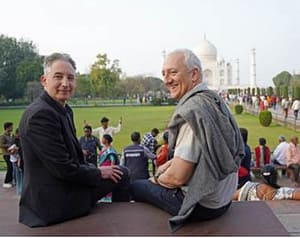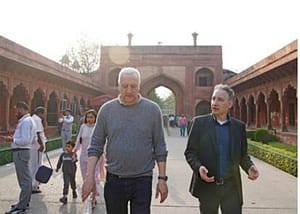As the morning tide gently laps against the shores of Navghar, Vandana Patil steps onto the damp earth of her village’s coastline. She recalls a time when the sea was generous, offering abundant crab and fish catch. But over the years, that generosity faded. “Earlier, we used to see unpredictable crab and fish catch and had to rely on other sources of livelihoods,” she says, her voice carrying the weight of years spent worrying about an uncertain future.
The culprit was clear: the unchecked destruction of mangroves. The towering green guardians of the coastline had been silently disappearing, their roots no longer anchoring the land, their dense canopies no longer sheltering marine life. With every tree lost, so too was a piece of the community’s livelihood. Yet, many in Navghar remained unaware of the deep connection between the mangroves and their survival.
Change arrived in the form of a far-reaching initiative. The Government of India, in collaboration with the Green Climate Fund and UNDP, launched a project to enhance climate resilience in India’s coastal communities. This initiative, operational across three coastal states-Andhra Pradesh, Maharashtra, and Odisha focused on conserving and restoring marine ecosystems, including mangroves, while creating climate-resilient livelihoods.
Navghar became a symbol of this transformation. In 2021, the project formed a Mangrove Co-Management Committee, bringing together village members, the Gram Panchayat, and women’s Self-Help Groups (SHGs). Their mission was twofold: protect the mangroves and revive local livelihoods. Women, often the most affected by economic instability, were placed at the forefront.
Through structured training, they learned sustainable crab farming techniques, creating new livelihood groups like Healthy Harvest and Wild Crab Aqua Farm. These groups now farm mud crabs over two acres of coastal land while ensuring the protection of mangroves from illegal cutting. The impact was immediate.
“Through our campaigns and drives, we have raised awareness about mangroves and their link to healthy fish catch and livelihoods,” explains Rohan Patil, president of the committee. “People no longer see them as just trees—they see them as protectors.”
By 2023, the once-barren coastline had transformed. The mangroves stood tall, shielding the land from erosion and storms, while the waters teemed with life again. The benefits extended beyond the environment. “The project helped us a lot,” Vandana shares. “Earlier, women worked only seasonally. Now, we have employment throughout the year. Besides, earlier we had to travel far and wide for crab farming; now, we can do it locally.”
What is Mangrove?
A mangrove is a salt-tolerant plant community found in tropical and subtropical intertidal regions. These ecosystems thrive in high-rainfall areas (1,000–3,000 mm) with temperatures ranging from 26°C to 35°C. Mangrove species are adapted to survive in waterlogged soils, high salinity, and frequent tidal surges. They serve as crucial biodiversity refuges and act as bio-shields against extreme climatic events. Additionally, rural populations depend on mangroves for biomass-based livelihoods.
India’s Progress in Mangrove Conservation
India has made significant strides in mangrove conservation through a combination of robust regulatory frameworks and targeted promotional initiatives. As per the India State of Forest Report 2023 (ISFR-2023), India’s total mangrove cover stands at 4,991.68 sq. km, constituting 0.15% of the nation’s geographical area. There has been net increase of 363.68 Sq.km (7.86%) in Mangrove cover area of the country in 2023 as compared to 2013 and net increase of 509.68 Sq.km (11.4%) between 2001 and 2023.
West Bengal holds the largest share of the country’s mangrove forests, accounting for 42.45% of the total cover, followed by Gujarat (23.32%) and the Andaman & Nicobar Islands (12.19%). Notably, Gujarat has recorded an impressive increase of 253.06 sq. km in mangrove cover between 2001 and 2023, attributed to large-scale plantations, community participation, and public-private partnerships.
Key Regulatory Measures
India has implemented a series of stringent legal frameworks to ensure mangrove protection:
- Coastal Regulation Zone (CRZ) Notification, 2019 under the Environment (Protection) Act, 1986, categorises mangroves as Ecologically Sensitive Areas (ESAs), restricting activities within a 50-metre buffer zone where mangrove cover exceeds 1,000 sq. m.
- Mandates compensatory replantation at a 3:1 ratio if mangroves are affected by development.
- Additional protection under the Wildlife (Protection) Act, 1972, Indian Forest Act, 1927, and Biological Diversity Act, 2002, among others.
Key Promotional Initiatives and Achievements
Mangrove Initiative for Shoreline Habitats & Tangible Incomes (MISHTI):
- Launched on 5 June 2023 to promote restoration and afforestation across 540 sq. km in 9 coastal States and 4 Union Territories.
- Implementation through convergence funding with the National Compensatory Afforestation Fund Management and Planning Authority (CAMPA).
- For FY 2024–25, ₹17.96 crore has been allocated to Andhra Pradesh, Gujarat, Kerala, Odisha, West Bengal, and Puducherry for the treatment and restoration of 3,836 hectares of degraded mangroves.
National Coastal Mission – Conservation of Mangroves and Coral Reefs:
- Financial assistance for the conservation of 38 mangrove sites and 4 coral reef sites across the country.
- Operates on a 60:40 cost-sharing model between the Centre and States.
- ₹8.58 crore released to seven coastal States during 2021–23 for mangrove conservation.
GCF-ECRICC Project (Green Climate Fund – Enhancing Coastal Resilience of Indian Coastal Community):
- Active since 2019 in Andhra Pradesh, Maharashtra, and Odisha.
- Aims to restore and conserve 10,575 hectares of mangroves.
- As of 2024, 3,114.29 hectares have been successfully restored.
Mangroves: Nature’s Carbon Vault
As per World Wildlife Fund mangroves store 7.5–10 times more carbon per acre than tropical forests. Their loss contributes to 10% of global greenhouse gas emissions from deforestation. These coastal forests hold over 21 gigatons of carbon, 87% of which is locked in the soil beneath their roots. Restoring just 1.6 million acres of lost mangrove forests could capture an additional 1 gigaton of carbon.
A Tidal Shift Towards Sustainability
Navghar’s transformation reflects a broader movement sweeping across India’s coastline where communities are not just adapting to change but actively shaping it. The revival of mangroves, once overlooked and degraded, now stands as a testament to collective action and inclusive development.
Through the integration of science, policy, and grassroots participation, India is forging a path where ecological restoration directly uplifts local economies. Women like Vandana Patil are no longer passive witnesses to environmental loss but active custodians of their natural heritage, securing livelihoods while nurturing resilience.
This shift marks more than environmental progress. It signals a future where nature-based solutions become central to climate action and communities, once vulnerable, emerge as champions of sustainable change.






















